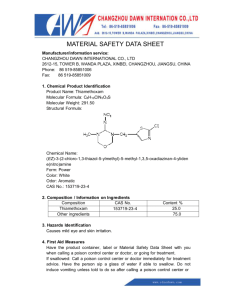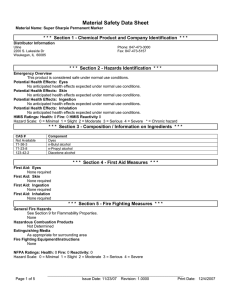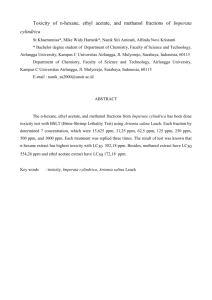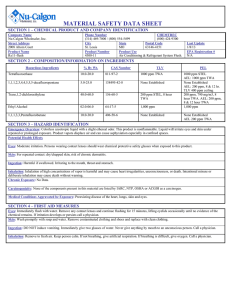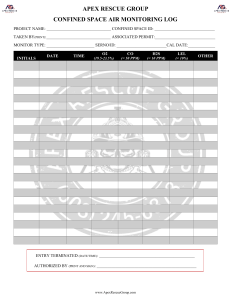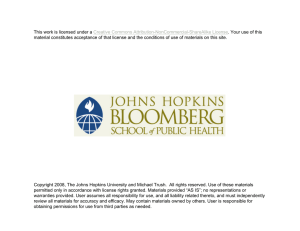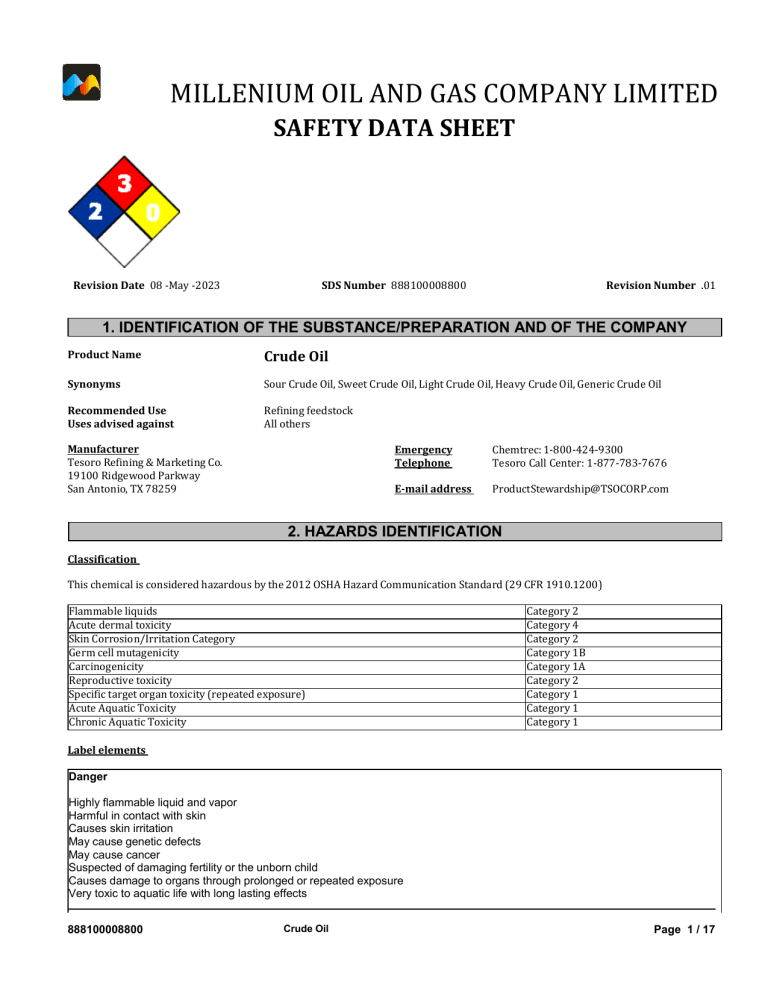
MILLENIUM OIL AND GAS COMPANY LIMITED SAFETY DATA SHEET Revision Date 08 -May -2023 SDS Number 888100008800 Revision Number .01 1. IDENTIFICATION OF THE SUBSTANCE/PREPARATION AND OF THE COMPANY Product Name Crude Oil Synonyms Sour Crude Oil, Sweet Crude Oil, Light Crude Oil, Heavy Crude Oil, Generic Crude Oil Recommended Use Uses advised against Refining feedstock All others Manufacturer Tesoro Refining & Marketing Co. 19100 Ridgewood Parkway San Antonio, TX 78259 Emergency Telephone Chemtrec: 1-800-424-9300 Tesoro Call Center: 1-877-783-7676 E-mail address ProductStewardship@TSOCORP.com 2. HAZARDS IDENTIFICATION Classification This chemical is considered hazardous by the 2012 OSHA Hazard Communication Standard (29 CFR 1910.1200) Flammable liquids Acute dermal toxicity Skin Corrosion/Irritation Category Germ cell mutagenicity Carcinogenicity Reproductive toxicity Specific target organ toxicity (repeated exposure) Acute Aquatic Toxicity Chronic Aquatic Toxicity Category 2 Category 4 Category 2 Category 1B Category 1A Category 2 Category 1 Category 1 Category 1 Label elements Danger Highly flammable liquid and vapor Harmful in contact with skin Causes skin irritation May cause genetic defects May cause cancer Suspected of damaging fertility or the unborn child Causes damage to organs through prolonged or repeated exposure Very toxic to aquatic life with long lasting effects 888100008800 Crude Oil Page 1 / 17 MILLENIUM OIL AND GAS COMPANY LIMITED Physical State @20°C Liquid Appearance Liquid Odor Petroleum asphalt odor. Hydrogen sulfide (H2S) has a characteristic rotten egg odor with an odor threshold as low as 10 parts per billion or even less. However, this odor should not be used as a warning property because H2S can deaden the sense of smell. H2S concentrations can be measured with an H2S meter or colorimetric indicating tubes. Precautionary Statements - Prevention Obtain special instructions before use Do not handle until all safety precautions have been read and understood Wear protective gloves/protective clothing/eye protection/face protection Wash face, hands and any exposed skin thoroughly after handling Do not breathe dust/fume/gas/mist/vapors/spray Do not eat, drink or smoke when using this product Keep away from heat/sparks/open flames/hot surfaces. - No smokingKeep container tightly closed Ground/or bond container and receiving equipment Use explosion-proof electrical/ ventilating / lighting / equipmentUse only non-sparking tools Take precautionary measures against static discharge Precautionary Statements - Response IF exposed or concerned: Get medical advice/attention Call a POISON CENTER or doctor if you feel unwell If skin irritation occurs: Get medical advice/attention IF ON SKIN (or hair): Take off immediately all contaminated clothing. Rinse skin with water/ shower Wash contaminated clothing before reuse In case of fire: Use CO2, dry chemical, or foam to extinguish Precautionary Statements - Storage Store in a well-ventilated place. Keep cool Precautionary Statements - Disposal Dispose of contents/container to an approved waste disposal plant Hazards not otherwise classified (HNOC) Not applicable Other Information May be harmful if swallowed. 3. COMPOSITION/INFORMATION ON INGREDIENTS Chemical Name Petroleum; Crude oil Sulfur Benzene N-hexane Xylene 888100008800 CAS-No 8002-05-9 7704-34-9 71-43-2 110-54-3 1330-20-7 Crude Oil Percent 0-100 0-5 0.1-3 0-1.5 0-<1 Page 2 / 17 MILLENIUM OIL AND GAS COMPANY LIMITED Toluene Polycyclic Aromatic Hydrocarbons Naphthalene Ethylbenzene Cumene Hydrogen Sulfide 108-88-3 130498-29-2 91-20-3 100-41-4 98-82-8 7783-06-4 0-<1 0-<1 0-<1 0-<1 0-<1 0-0.5 4. FIRST AID MEASURES Description of first aid measures General advice Show this safety data sheet to the doctor in attendance. Remove from exposure, lie down. In case of accident or if you feel unwell, seek medical advice immediately. When symptoms persist or in all cases of doubt, seek medical advice. Never give anything bymouth to an unconscious person. Take off all contaminated clothing immediately and thoroughly wash material from skin. Inhalation Remove to fresh air. Get medical attention immediately if symptoms occur. Eye contact Rinse immediately with plenty of water, also under the eyelids, for at least 15 minutes. Keepeye wide open while rinsing. Do not rub affected area. Remove contact lenses, if present and easy to do. Continue rinsing. Get medical attention if irritation develops and persists. Skin contact Wash off immediately with soap and plenty of water while removing all contaminated clothes and shoes. If symptoms persist, call a physician. Ingestion Do NOT induce vomiting. Clean mouth with water and drink afterwards plenty of water. Never give anything by mouth to an unconscious person. Call a physician. Self-protection of the first aider Remove all sources of ignition. Ensure that medical personnel are aware of the material(s) involved, take precautions to protect themselves and prevent spread of contamination. Use personal protective equipment as required. See section 8 for more information. Wear personal protective clothing (see section 8). Avoid contact with skin, eyes or clothing. Most important symptoms and effects, both acute and delayed Indication of any immediate medical attention and special treatment needed Note to physicians Treat symptomatically. 5. FIRE-FIGHTING MEASURES Suitable Extinguishing Media Dry chemical. Carbon dioxide (CO2). Water spray. Alcohol resistant foam. Small Fire Any extinguisher suitable for Class B fires, dry chemical, CO2, foam (AFFF/ATC), or water spray can be used. Large Fire Water spray, fog or alcohol-resistant foam. CAUTION: Use of water spray when fighting fire may be inefficient. Cool containers with flooding quantities of water until well after fire is out. Unsuitable extinguishing media CAUTION: Use of water spray when fighting fire may be inefficient. Specific hazards arising from the chemical Risk of ignition. Keep product and empty container away from heat and sources of ignition. In the event of fire, cool tanks with water spray. Fire residues and contaminated fire extinguishing water must be disposed of in accordance with local regulations. Hazardous combustion products Smoke, CO, and other products of incomplete combustion. Explosion data Sensitivity to Mechanical Impact None. 888100008800 Crude Oil Page 3 / 17 MILLENIUM OIL AND GAS COMPANY LIMITED Sensitivity to Static Discharge Yes. Special protective equipment for fire-fighters Firefighters should wear self-contained breathing apparatus and full firefighting turnout gear. For massive fire, use unmanned hose holders or monitor nozzles; if this is impossiblewithdraw from area and let fire burn. Further information ALWAYS stay away from tanks engulfed in fire. Fight fire from maximum distance or use unmanned hose holders or monitor nozzles. Withdraw immediately in case of rising sound from venting safety devices or discoloration of tank. Do not direct water at source of leak or safety devices; icing may occur. Cool containers with flooding quantities of water until well after fire is out. Do not allow run-off from fire-fighting to enter drains or water courses. NFPA Health hazards 2 Flammability 3 Stability 0 Physical and chemical properties - 6. ACCIDENTAL RELEASE MEASURES Personal precautions, protective equipment and emergency procedures Personal precautions Evacuate personnel to safe areas. Use personal protective equipment as required. See section 8 for more information. Avoid contact with skin, eyes or clothing. Ensure adequate ventilation. Keep people away from and upwind of spill/leak. ELIMINATE all ignition sources(no smoking, flares, sparks or flames in immediate area). Pay attention to flashback. Take precautionary measures against static discharges. All equipment used when handling the product must be grounded. Do not touch or walk through spilled material. Other Information Ventilate the area. Refer to protective measures listed in Sections 7 and 8. Environmental precautions Environmental precautions Refer to protective measures listed in Sections 7 and 8. Prevent further leakage or spillageif safe to do so. Prevent product from entering drains. Methods and material for containment and cleaning up Methods for containment Stop leak if you can do it without risk. Do not touch or walk through spilled material. A vapor suppressing foam may be used to reduce vapors. Dike far ahead of spill to collect runoff water. Keep out of drains, sewers, ditches and waterways. Absorb with earth, sand or othernoncombustible material and transfer to containers for later disposal. Methods for cleaning up Take precautionary measures against static discharges. Dam up. Soak up with inert absorbent material. Pick up and transfer to properly labeled containers. Prevention of secondary hazards Clean contaminated objects and areas thoroughly observing environmental regulations. 7. HANDLING AND STORAGE Precautions for safe handling Advice on safe handling Use personal protection equipment. Avoid contact with skin and eyes. Avoid breathing vapors or mists. Keep away from heat/sparks/open flames/hot surfaces. - No smoking. Use grounding and bonding connection when transferring this material to prevent static discharge, fire or explosion. Use with local exhaust ventilation. Use spark-proof tools and explosion-proof equipment. Keep in an area equipped with sprinklers. Use according to package label instructions. Handle in accordance with good industrial hygiene and safety practice. Avoid contact with skin, eyes or clothing. Do not eat, drink or smoke when using this product. Remove contaminated clothing and shoes. Take off contaminated clothing andwash before reuse. Conditions for safe storage, including any incompatibilities 888100008800 Crude Oil Page 4 / 17 MILLENIUM OIL AND GAS COMPANY LIMITED Storage Conditions Keep containers tightly closed in a dry, cool and well-ventilated place. Keep away from heat, sparks, flame and other sources of ignition (i.e., pilot lights, electric motors and static electricity). Keep in properly labeled containers. Do not store near combustible materials. Keep in an area equipped with sprinklers. Store in accordance with the particular national regulations. Store in accordance with local regulations. Store locked up. 8. EXPOSURE CONTROLS/PERSONAL PROTECTION Chemical Name Petroleum; Crude oil 8002-05-9 ACGIH TLV - Benzene 71-43-2 STEL: 2.5 ppm TWA: 0.5 ppm S* N-hexane 110-54-3 TWA: 50 ppmS* Xylene 1330-20-7 STEL: 150 ppm TWA: 100 ppm Toluene 108-88-3 TWA: 20 ppm Naphthalene 91-20-3 TWA: 10 ppmS* Ethylbenzene 100-41-4 TWA: 20 ppm Cumene 98-82-8 TWA: 50 ppm Hydrogen Sulfide STEL: 5 ppm 888100008800 Crude Oil OSHA PEL TWA: 500 ppm TWA: 2000 mg/m3 (vacated) TWA: 400 ppm (vacated) TWA: 1600 mg/m3 TWA: 10 ppm applies to industry segments exempt from the benzene standard at 29 CFR 1910.1028 TWA: 1 ppm (vacated) TWA: 10 ppm unless specifiedin 1910.1028 (vacated) STEL: 50 ppm 10 min unless specified in 1910.1028 (vacated) Ceiling: 25 ppm unlessspecified in 1910.1028 Ceiling: 25 ppm STEL: 5 ppm see 29 CFR 1910.1028 TWA: 500 ppm TWA: 1800 mg/m3 (vacated) TWA: 50 ppm (vacated) TWA: 180 mg/m3 TWA: 100 ppm TWA: 435 mg/m3 (vacated) TWA: 100 ppm (vacated) TWA: 435 mg/m3 (vacated) STEL: 150 ppm (vacated) STEL: 655 mg/m3 TWA: 200 ppm (vacated) TWA: 100 ppm (vacated) TWA: 375 mg/m3 (vacated) STEL: 150 ppm (vacated) STEL: 560 mg/m3 Ceiling: 300 ppm TWA: 10 ppm TWA: 50 mg/m3 (vacated) TWA: 10 ppm (vacated) TWA: 50 mg/m3 (vacated) STEL: 15 ppm (vacated) STEL: 75 mg/m3 TWA: 100 ppm TWA: 435 mg/m3 (vacated) TWA: 100 ppm (vacated) TWA: 435 mg/m3 (vacated) STEL: 125 ppm (vacated) STEL: 545 mg/m3 TWA: 50 ppm TWA: 245 mg/m3 (vacated) TWA: 50 ppm (vacated) TWA: 245 mg/m3 (vacated) S* S* (vacated) TWA: 10 ppm Page 5 / 17 MILLENIUM OIL AND GAS COMPANY LIMITED 7783-06-4 TWA: 1 ppm (vacated) TWA: 14 mg/m3 (vacated) STEL: 15 ppm (vacated) STEL: 21 mg/m3 Ceiling: 20 ppm S* - Potential exposure by cutaneous route NOTE: Limits shown for guidance only. For additional information, OSHA’s 1989 air contaminants standard exposure limits provided even though the limits were vacated in 1992. State, local or other agencies or advisory groups may have established more stringent limits. Follow applicable regulations. Appropriate engineering controls Engineering controls Showers Eyewash stations Ventilation systems. Individual protection measures, such as personal protective equipment Eye/face protection Tight sealing safety goggles. Hand Protection Wear suitable gloves. Impervious gloves. Skin and body protection Wear suitable protective clothing. Long sleeved clothing. Chemical resistant apron. Antistatic boots. Respiratory protection When workers are facing concentrations above the exposure limit they must use appropriate certified respirators. Use a NIOSH approved respirator when there is a potential for airborne concentrations to exceed occupational exposure limits. Refer to OSHA 29 CFR 1910.134, ANSI Z88.2, NIOSH Respirator Decision Logic, and the respirator manufacturer for additional guidance on respiratory protection selection. A Self-Contained Breathing Apparatus (SCBA) should be used for fire fighting. Use a NIOSH approved positive-pressure supplied air respirator if there is a potential for uncontrolled release, exposure levels are unknown, in oxygen deficient (less than 19.5% oxygen), or any other circumstance where an air-purifying respirator may not provide adequate protection. General hygiene considerations Do not eat, drink or smoke when using this product. Contaminated work clothing should not be allowed out of the workplace. Regular cleaning of equipment, work area and clothing is recommended. Wash hands before breaks and immediately after handling the product. Avoid contact with skin, eyes or clothing. Wear suitable gloves and eye/face protection. 9. PHYSICAL AND CHEMICAL PROPERTIES Information on basic physical and chemical properties Physical State @20°C Liquid Appearance Liquid Odor Petroleum asphalt odor. Hydrogen sulfide (H2S) has a characteristic rotten egg odor with an odor threshold as low as 10 parts per billion or even less. However, this odor should notbe used as a warning property because H2S can deaden the sense of smell. H2S concentrations can be measured with an H2S meter or colorimetric indicating tubes. Color Dark yellow to brown or greenish black Odor threshold Odor threshold varies with the composition of the crude oil Property pH Melting point / freezing point Boiling range Flash point Evaporation rate Flammability (solid, gas) Values Not applicable -30 °C / -22 °F 300 °C -7 °C / 19 °F No data available Flammable gas or vapor may be released by liquid Remarks • Method Flammability Limit in Air % 888100008800 Crude Oil Page 6 / 17 MILLENIUM OIL AND GAS COMPANY LIMITED Upper flammability limit: Lower flammability limit: Vapor pressure Vapor density Relative density Water solubility Solubility in other solvents Partition coefficient Autoignition temperature Decomposition temperature Kinematic viscosity Dynamic viscosity Explosive properties Oxidizing properties Minimum Ignition Energy (mJ) K st (bar.m/s) Softening point VOC Content (%) Density Bulk density Conductivity 7 0.7 6 to 45 No data available 0.8 to 1.0 1 to 2% by weight is maximum reported for soluble components of crude oil No data available 2 to > 6 No data available °C / °F No data available 5 to > 1300 mm2/s No data available No data available No data available No data available No data available No data available No data available No data available Not applicable No data available 10. STABILITY AND REACTIVITY Reactivity This product is non-reactive under normal conditions. Chemical stability Stable under recommended storage conditions. Possibility of hazardous reactions None under normal processing. Conditions to avoid Heat, flames and sparks. Incompatible materials Strong acids. Strong bases. Strong oxidizing agents. Hazardous decomposition products None under normal use conditions. 11. TOXICOLOGICAL INFORMATION Information on likely routes of exposure Inhalation Specific test data for the substance or mixture is not available. May cause irritation of respiratory tract. Eye contact Specific test data for the substance or mixture is not available. Irritating to eyes. (based on components). Skin contact Specific test data for the substance or mixture is not available. Causes skin irritation. (basedon components). Ingestion Specific test data for the substance or mixture is not available. Ingestion may cause gastrointestinal irritation, nausea, vomiting and diarrhea. Information on toxicological effects Symptoms Redness. May cause redness and tearing of the eyes. Numerical measures of toxicity Acute toxicity 888100008800 Crude Oil Page 7 / 17 MILLENIUM OIL AND GAS COMPANY LIMITED The following values are calculated based on chapter 3.1 of the GHS (Globally Harmonized System) document. ATEmix (oral) 3,093.00 mg/kg ATEmix (dermal) 1,836.00 mg/kg ATEmix (inhalation-dust/mist) 8.00 mg/l ATEmix (inhalation-vapor) 1,809.77 mg/l Inhalation LC50 > 4300 mg/kg ( Rat ) LD50/dermal/rat - NO UNITS (Wizards mg/kg) > 2000 mg/kg ( Rabbit ) > 3000 mg/kg ( Rat ) > 2000 mg/kg ( Rabbit ) > 9.23 mg/L ( Rat ) 4 h = 1800 mg/kg ( Rat ) = 810 mg/kg ( Rat ) = 25 g/kg ( Rat ) > 8200 mg/kg ( Rabbit ) = 44.66 mg/L ( Rat ) 4 h = 3000 mg/kg ( Rabbit ) = 48000 ppm ( Rat ) 4 h = 3500 mg/kg ( Rat ) = 2600 mg/kg ( Rat ) > 1700 mg/kg ( Rabbit ) > 4350 mg/kg ( Rabbit ) = 12000 mg/kg ( Rabbit ) = 29.08 mg/L ( Rat ) 4 h = 5000 ppm ( Rat ) 4 h = 12.5 mg/L ( Rat ) 4 h = 1110 mg/kg ( Rat ) = 490 mg/kg ( Rat ) = 3500 mg/kg ( Rat ) = 1120 mg/kg ( Rabbit ) > 20 g/kg ( Rabbit ) = 15400 mg/kg ( Rabbit ) > 340 mg/m3 ( Rat ) 1 h = 1400 mg/kg ( Rat ) = 12300 µL/kg ( Rabbit ) - - Chemical Name Oral LD50 Petroleum; Crude oil 8002-05-9 Sulfur 7704-34-9 Benzene 71-43-2 N-hexane 110-54-3 Xylene 1330-20-7 Toluene 108-88-3 Naphthalene 91-20-3 Ethylbenzene 100-41-4 Cumene 98-82-8 Hydrogen Sulfide 7783-06-4 - = 17.4 mg/L ( Rat ) 4 h = 39000 mg/m3 ( Rat ) 4 h > 3577 ppm ( Rat ) 6 h = 700 mg/m3 ( Rat ) 4 h Delayed and immediate effects as well as chronic effects from short and long-term exposure Chemical Name Benzene N-hexane 888100008800 Benzene exposure may occur through inhalation, ingestion, skin absorption or eye contact. Benzene exposure can cause skin, eye and respiratory irritation. The most characteristic systemic effect resulting from high enough intermediate and chronic benzene exposure is arrested development of blood cells. Studies have linked overexposure to benzene to many hematological effects including aplastic anemia, pancytopenia, leukopenia, and myelodysplastic syndrome. In vivo and in vitro data from both humans and animals show that benzene and/or its metabolites are genotoxic. Studies in animals provide supporting evidence for the carcinogenicity of inhaled benzene. Epidemiological studies have reporteda causal relationship between occupational benzene exposures and acute myelogenous leukemia. Some studies suggest associations between benzene exposure and non-Hodgkin’s lymphoma, multiple myeloma, and other cancers. Benzene has been classified as carcinogenic to humans (Group 1) by IARC, and the ECHA C&L Inventory states it may cause cancer (Carc. 1B). IARC concluded that benzene causes acute myeloid leukemia and a positive association has been observed for acute lymphatic leukemia, chronic lymphatic leukemia, nonhodgkin lymphoma, and multiple myeloma. Human studiessuggest that female fertility and menstrual cycles were effected by benzene exposure; however, due to uncertainties in exposure and limited data the studies were considered inconclusive. Developmental effects have been observed in animals including persistent hematopoietic anomalies. It has been suggested that the reported benzene fetotoxicity of decreased weight and skeletal variants is a function of maternal toxicity. N-Hexane may be fatal if it is swallowed and enters the airways. Acute (short-term) dermal overexposure can cause skin and eye irritation in humans. Acute inhalation and oral exposures have caused systemic effects such as decreased body weight and respiratory effects, as well as reproductive and developmental effects in animals. Respiratory effects may include nose, throat, and lung irritation, coughing, wheezing, and shortness of breath. Acute overexposures may also cause headache, nausea, vomiting, dizziness, lightheadedness, loss of consciousness, coma, and death in human. Intermediate duration inhalation and oral exposures to relatively high concentrations (400-3,000 ppm) of n-hexane have led to nerve damage, paralysis, and/or Crude Oil Page 8 / 17 MILLENIUM OIL AND GAS COMPANY LIMITED deaths in rats. N-hexane may damage male 888100008800 Crude Oil Page 9 / 17 MILLENIUM OIL AND GAS COMPANY LIMITED reproductive glands. Intermediate-duration inhalation and oral exposure to high levels (1,00010,000 ppm; 4,000 mg/kg/day) of n-hexane damages sperm-forming cells and testicles in rats. Chronic (long-term) inhalation of large amounts of n-hexane causes nerve damage and paralysis of the arms and legs in humans. Dermal effects, such as a skin rash,dryness, or redness can also occur following chronic overexposure. Chronic duration inhalation exposures in animals are not available. Xylene Mixed xylenes can cause skin, eye, and respiratory irritation. Both short- and long-term repeated exposures to high enough levels in humans have resulted in a variety of adverse nervous system effects that include headache, mental confusion, narcosis, equilibrium, impaired short-term memory, dizziness and tremors. Studies in laboratory animals indicate that xylene can cause changes in the liver and harmful effects on the kidneys, lungs, heart, and nervous system as well as hearing loss. The relevance of these observations to humans is not clear at this time. In general, developmental studies in animals reported adverse fetal effects only at concentrations that caused maternal toxicity. The relevance of these observations to humans is unclear at this time. The available data from in vitro and invivo studies suggest that xylenes are not mutagenic and do not produce chromosomal abnormalities. Furthermore, rats exposed up to 500 mg/kg bw and mice exposed up to 1000 mg/kg bw mixed xylenes for 103 weeks showed no treatment-related increases in anytumor type. IARC has determined that the carcinogenicity of xylenes is not classifiable (Group 3). Naphthalene Acute (short term) exposure to large amounts of naphthalene may damage or destroy red blood cells, a condition termed hemolytic anemia. Symptoms of hemolytic anemia include fatigue, lack of appetite, restlessness, and pale skin. Acute inhalation or oral exposure to large amounts of naphthalene may also cause nausea, vomiting, diarrhea, blood in the urine, and a yellow color to the skin. Ingestion may result in death. Chronic (long term) exposure in rats and mice can lead to irritation and inflammation of their nose and lungs; nasal hyperplasia and metaplasia in respiratory and olfactory epithelium has been reportedin studies in mice. Exposure to high enough levels may have effects on the blood, resultingin chronic hemolytic anemia, and effects on the eyes, resulting in the development of cataracts. Cancer from naphthalene exposure has been observed in animals, but not humans. IARC has classified naphthalene as possibly carcinogenic to humans (Group 2B),and the ECHA C&L Inventory reports that naphthalene is suspected of causing cancer (Carc. 2). Ethylbenzene Ethylbenzene may be fatal if it is swallowed and enters the airways. Short term (acute) exposure to ethylbenzene can cause eye, skin, and throat irritation. It may have effects onthe central nervous system including dizziness, and at very high exposure, lowering on consciousness. Long-term exposures orally and by inhalation have been shown to cause damage to the inner ear and hearing in animals. Long term or repeated exposure to high enough levels of ethylbenzene may have effects on the kidneys and liver, resulting in impaired functions, and repeated contact with skin may cause dryness and cracking. Animal studies indicate some evidence of adverse effects on the liver, kidney, thyroid, and pituitary gland. In a 2-year inhalation study in mice and rats, the animals were exposed to 0,75, 250, and 750 ppm ethylbenzene 6 hours/day, 5 days/week. Renal effects were observed in male rats (renal tubule hyperplasia) and female rats (renal tubule adenoma andadenoma or carcinoma) exposed to 750 ppm. The incidence of adenoma in the testes of males was significantly greater than in the control group and exceeded the historical control range for inhalation studies. The incidences of alveolar/bronchiolar adenoma was increasedin males and the incidence of hepatocellular adenoma was increased in females. IARC has classified ethylbenzene as possibly carcinogenic to humans (Group 2B). Studies do not provide conclusive evidence of reproductive effects. In one study, developmental effects were reported in animals but only at very high doses (≥1000 ppm) that are likely to be toxic to the mother. The relevance of these findings to humans is not clear at this time. Cumene Cumene may be fatal if it is swallowed and enters the airways. Cumene targets the eyes, skin, respiratory system, and central nervous system. Short term (acute) exposure may result in irritation of the eyes, skin and mucous membranes, headache, narcosis, and coma.At high enough levels, repeated or prolonged contact with skin may cause dermatitis. Acute exposures to cumene in animal studies has been shown to result in neurotoxicological effects at concentrations > 500 ppm. A cumene concentration of 2,058 ppm has been shown to result in a 50% reduction in the respiratory rate of mice. In animals, an increase in organ weights, primarily the kidneys, are the most prominent effects observed in rodents 888100008800 Crude Oil Page 10 / 17 MILLENIUM OIL AND GAS COMPANY LIMITED repeatedly exposed to cumene by either the oral or inhalation route. No adverse effects were observed in rat or rabbit fetuses whose mothers had been exposed to cumene duringfetal development. Cumene is classified as possibly carcinogenic to humans by IARC (Group 2B). Hydrogen Sulfide Hydrogen Sulfide may be fatal if inhaled. The nervous system and respiratory tract are the main targets of hydrogen sulfide toxicity. Short term (acute) overexposure may cause irritation to the eyes, nose or throat. At high enough levels, effects on the nervous system include headaches, poor concentration, poor memory, unconsciousness, and death. Hydrogen sulfide has a strong odor that is characteristic of rotten eggs; however, the odor is not a reliable warning property as olfactory fatigue occurs at high levels. Respiratory distress or arrest can occur at high concentrations. Direct contact of the liquid with skin cancause frostbite; contact with the eyes can cause redness or severe burns. Cardiovascular effects have also been observed. NIOSH has determined that 100 ppm is immediately dangerous to life and health. Health hazard and classification information Skin Corrosion/Irritation Category Classification based on data available for ingredients. Irritating to skin. Serious eye damage/eye irritation No information available. No information available. Germ cell mutagenicity Classification based on data available for ingredients. Contains a known or suspected mutagen. The table below indicates ingredients above the cut-off threshold considered as relevant which are listed as mutagenic. Carcinogenicity Classification based on data available for ingredients. Contains a known or suspected carcinogen. The table below indicates whether each agency has listed any ingredient as a carcinogen. Chemical Name ACGIH IARC NTP Petroleum; Crude oil A2 Group 3 Known 8002-05-9 Benzene A1 Group 1 Known 71-43-2 Xylene Group 3 1330-20-7 Toluene Group 3 108-88-3 Naphthalene A3 Group 2B Reasonably Anticipated 91-20-3 Ethylbenzene A3 Group 2B 100-41-4 Cumene Group 2B Reasonably Anticipated 98-82-8 OSHA X X X X X Reproductive toxicity Classification based on data available for ingredients. Contains a known or suspected reproductive toxin. The table below indicates ingredients above the cut-off thresholdconsidered as relevant which are listed as reproductive toxins. Target Organ Systemic Toxicant Single Exposure No information available. Target Organ Systemic Toxicant Repeated Exposure Causes damage to organs through prolonged or repeated exposure. Target organ effects liver, kidney, Respiratory system, Eyes, Skin, Central nervous system, blood, Peripheral Nervous System (PNS), bone marrow. Aspiration hazard No information available. 888100008800 Crude Oil Page 11 / 17 MILLENIUM OIL AND GAS COMPANY LIMITED 12. ECOLOGICAL INFORMATION Additional Ecological Information Ecotoxicity Release of this product should be prevented from contaminating soil and water and from entering drainage and sewer systems. U.S.A. regulations require reporting spills of this material that could reach any surface waters. The toll-free number to the U.S. Coast GuardNational Response Center is (800) 424-8802 Very toxic to aquatic life with long-lasting effects. Chemical Name Algae/aquatic plants Fish Petroleum; Crude oil 8002-05-9 - 258: 96 h Salmo gairdneri mg/L LC50 static Sulfur 7704-34-9 Benzene 71-43-2 N-hexane 110-54-3 Xylene 1330-20-7 888100008800 14: 96 h Lepomis macrochirus mg/L LC50 static 866: 96 h Brachydanio rerio mg/L LC50 static 180: 96 h Oncorhynchus mykiss mg/L LC50 static 29: 72 h 10.7 - 14.7: 96 h Pseudokirchneriella Pimephales promelas subcapitata mg/L EC50 mg/L LC50 flow-through 5.3: 96 h Oncorhynchus mykiss mg/L LC50 flow-through 22.49: 96 h Lepomis macrochirus mg/L LC50 static 28.6: 96 h Poecilia reticulata mg/L LC50 static 22330 41160: 96 h Pimephales promelas µg/L LC50 static 70000 - 142000: 96 h Lepomis macrochirus µg/L LC50 static 2.1 - 2.98: 96 h Pimephales promelas mg/L LC50 flow-through 13.4: 96 h Pimephales promelas mg/L LC50 flow-through 780: 96 h Cyprinus carpio mg/L LC50 semi-static 780: 96h Cyprinus carpio mg/L LC50 13.5 - 17.3: 96 h Oncorhynchus mykiss mg/L LC50 19: 96 h Lepomis macrochirus mg/L LC50 13.1 - 16.5: 96 h Lepomis macrochirus mg/L LC50 flow-through 23.53 29.97: 96 h Pimephales promelas mg/L LC50 static 30.26 - 40.75: 96 h Poecilia reticulata mg/L LC50 static 2.661 - 4.093: 96 h Oncorhynchus mykiss mg/L LC50 static 7.711 - Crude Oil Toxicity to microorganisms - - Crustacea 36: 24 h Daphnia magna mg/L EC50 0.26: 48 h Daphnia magna mg/L EC50 Static - - 10: 48 h Daphnia magna mg/L EC50 8.76 - 15.6: 48 h Daphnia magnamg/L EC50 Static - 1000: 24 h Daphnia magna mg/L EC50 - 0.6: 48 h Gammarus lacustris mg/L LC50 3.82: 48 h water flea mg/L EC50 Page 12 / 17 MILLENIUM OIL AND GAS COMPANY LIMITED Toluene 108-88-3 12.5: 72 h Pseudokirchneriella subcapitata mg/L EC50 static 433: 96 h Pseudokirchneriella subcapitata mg/L EC50 Naphthalene 91-20-3 0.4: 72 h Skeletonema costatum mg/L EC50 Ethylbenzene 100-41-4 438: 96 h Pseudokirchneriella subcapitata mg/L EC50 4.6: 72 h Pseudokirchneriella subcapitata mg/L EC50 1.7 - 7.6: 96 h Pseudokirchneriella subcapitata mg/L EC50 static 2.6 - 11.3: 72 h Pseudokirchneriella subcapitata mg/L EC50 static Cumene 98-82-8 2.6: 72 h Pseudokirchneriella subcapitata mg/L EC50 888100008800 Crude Oil 9.591: 96 h Lepomis macrochirus mg/L LC50 static 12.6: 96 h Pimephales promelas mg/L LC50 static 5.89 - 7.81: 96 h Oncorhynchus mykiss mg/L LC50 flow-through 15.22 - 19.05: 96 h Pimephales promelas mg/L LC50 flow-through 5.8: 96 h Oncorhynchus mykiss mg/L LC50 semi-static 11.0 - 15.0: 96 h Lepomis macrochirus mg/L LC50 static 50.87 - 70.34: 96 h Poecilia reticulata mg/L LC50 static 14.1 - 17.16: 96 h Oncorhynchus mykiss mg/L LC50 static 28.2: 96 h Poecilia reticulata mg/L LC50 semi-static 54: 96 h Oryzias latipes mg/L LC50 static 5.74 - 6.44: 96 h Pimephales promelas mg/L LC50 flow-through 31.0265: 96 h Lepomis macrochirus mg/L LC50 static 0.91 - 2.82: 96 h Oncorhynchus mykiss mg/L LC50 static 1.6: 96 h Oncorhynchus mykiss mg/L LC50 flow-through 1.99: 96 h Pimephales promelas mg/L LC50 static 4.2: 96 h Oncorhynchus mykiss mg/L LC50 semi-static 7.55 - 11: 96 h Pimephales promelas mg/L LC50 flow-through 9.6: 96 h Poecilia reticulata mg/L LC50 static 9.1 - 15.6: 96 h Pimephales promelas mg/L LC50 static 11.0 18.0: 96 h Oncorhynchus mykiss mg/L LC50 static 32: 96 h Lepomis macrochirus mg/L LC50 static 6.04 - 6.61: 96 h Pimephales promelas mg/L LC50 flow-through 4.8: 96 h Oncorhynchus mykiss mg/L LC50 flow-through 5.1: 96 h Poecilia reticulata mg/L LC50 semi-static 2.7: 96h Oncorhynchus mykiss - 11.5: 48 h Daphnia magna mg/L EC50 5.46 -9.83: 48 h Daphnia magna mg/L EC50 Static - 1.96: 48 h Daphnia magna mg/L EC50 Flowthrough 1.09 - 3.4: 48 h Daphnia magna mg/L EC50 Static 2.16: 48 h Daphnia magna mg/L LC50 - 1.8 - 2.4: 48 h Daphnia magna mg/L EC50 - 0.6: 48 h Daphnia magna mg/L EC50 7.9 - 14.1: 48 h Daphnia magna mg/L EC50 Static Page 13 / 17 MILLENIUM OIL AND GAS COMPANY LIMITED Hydrogen Sulfide 7783-06-4 mg/L LC50 semi-static 0.016: 96 h Pimephales promelas mg/L LC50 flow-through 0.0448: 96 h Lepomis macrochirus mg/L LC50 flow-through - Persistence and degradability No information available. Bioaccumulation There is no data for this product. Component Information Chemical Name Benzene 71-43-2 Xylene 1330-20-7 Toluene 108-88-3 Naphthalene 91-20-3 Ethylbenzene 100-41-4 Cumene 98-82-8 Hydrogen Sulfide 7783-06-4 Other adverse effects - 0.022: 96 h Gammarus pseudolimnaeus mg/L LC50 Partition coefficient 2.1 2.77 - 3.15 2.7 3.6 3.2 3.7 0.45 No information available. 13. DISPOSAL CONSIDERATIONS Waste treatment methods Waste from residues/unused products Should not be released into the environment. Dispose of in accordance with localregulations. Dispose of waste in accordance with environmental legislation. Contaminated packaging Empty containers pose a potential fire and explosion hazard. Do not cut, puncture of weld containers. US EPA Waste Number U019 U055 U135 U165 U220 U239 D001. Chemical Name Benzene 71-43-2 RCRA U019 Xylene 1330-20-7 Toluene 108-88-3 - Polycyclic Aromatic Hydrocarbons 130498-29-2 Naphthalene 888100008800 RCRA - Basis for Listing RCRA - D Series Wastes Included in waste 0.5 mg/L regulatory level streams: F005, F024, F025, F037, F038, F039, K085, K104, K105, K141, K142, K143, K144, K145, K147, K151, K159, K169, K171, K172 Included in waste stream: F039 Included in waste streams: F005, F024, F025, F039, K015, K036, K037, K149, K151 Included in waste stream: K022 U220 U165 Included in waste Crude Oil - RCRA - U Series Wastes U019 U239 U220 U165 Page 14 / 17 MILLENIUM OIL AND GAS COMPANY LIMITED - streams: F024, F025, F034, F039, K001, K035, K060, K087, K145 Included in waste stream: F039 - U135 - 91-20-3 Ethylbenzene 100-41-4 Cumene 98-82-8 Hydrogen Sulfide 7783-06-4 Chemical Name Toluene 108-88-3 Naphthalene 91-20-3 - RCRA - Halogenated Organic Compounds - - RCRA - P Series Wastes - - - - - U055 - U135 RCRA - F Series Wastes RCRA - K Series Wastes Toxic waste waste number F025 Waste description: Condensed light ends, spent filters and filter aids, and spent desiccant wastes from the production of certain chlorinated aliphatic hydrocarbons, by free radical catalyzed processes. These chlorinated aliphatic hydrocarbons are those having carbon chain lengths ranging from one to and including five, with varying amounts and positions of chlorine substitution. Toxic waste waste number F025 Waste description: Condensed light ends, spent filters and filter aids, and spent desiccant wastes from the production of certain chlorinated aliphatic hydrocarbons, by free radical catalyzed processes. These chlorinated aliphatic hydrocarbons are those having carbon chain lengths ranging from one to and including five, with varying amounts and positions of chlorine substitution. - - California Hazardous Waste Status This product contains one or more substances that are listed with the State of California as a hazardous waste. Chemical Name Benzene 71-43-2 N-hexane 110-54-3 Xylene 1330-20-7 888100008800 California Hazardous Waste Status Toxic Ignitable Toxic Ignitable Toxic Ignitable Crude Oil Page 15 / 17 MILLENIUM OIL AND GAS COMPANY LIMITED Toluene 108-88-3 Naphthalene 91-20-3 Ethylbenzene 100-41-4 Cumene 98-82-8 Toxic Ignitable Toxic Toxic Ignitable Toxic Ignitable 14. TRANSPORT INFORMATION DOT UN/ID no Proper Shipping Name Hazard Class Packing group Reportable Quantity (RQ) Special Provisions Description Emergency Response Guide Number UN1267 PETROLEUM CRUDE OIL 3 I Hydrogen sulfide H2S: RQ kg= 9080.00, Benzene: RQ kg= 151.33, Naphthalene: RQ kg= 4540.00, Xylenes mixed isomers: RQ kg= 4540.00 357, T11, TP1, TP8, 144 UN1267, Petroleum crude oil, 3, I, RQ 128 TDG UN/ID no Proper Shipping Name Hazard Class Packing group Description UN1267 PETROLEUM CRUDE OIL 3 I UN1267, Petroleum crude oil, 3, I MEX UN/ID no Proper Shipping Name Hazard Class Special Provisions Packing group Description UN1267 PETROLEUM CRUDE OIL 3 357 I UN1267, Petroleum crude oil, 3, I IATA UN/ID no Proper Shipping Name Hazard Class Packing group Description UN1267 PETROLEUM CRUDE OIL 3 I or II, depending on composition UN1267, Petroleum crude oil, 3, I IMDG UN/ID no Proper Shipping Name Hazard Class Packing group EmS No. Special Provisions Description UN1267 PETROLEUM CRUDE OIL 3 I F-E, S-E 357 UN1267, Petroleum crude oil, 3, I, (-7°C c.c.) International Inventories TSCA DSL/NDSL ENCS IECSC 888100008800 15. REGULATORY INFORMATION Not Listed Not Listed Not Listed Not Listed Crude Oil Page 16 / 17 MILLENIUM OIL AND GAS COMPANY LIMITED KECL PICCS AICS Not Listed Not Listed Not Listed Legend: TSCA - United States Toxic Substances Control Act Section 8(b) Inventory DSL/NDSL Canadian Domestic Substances List/Non-Domestic Substances ListENCS - Japan Existing and New Chemical Substances IECSC - China Inventory of Existing Chemical Substances KECL - Korean Existing and Evaluated Chemical Substances PICCS - Philippines Inventory of Chemicals and Chemical Substances AICS - Australian Inventory of Chemical Substances US Federal Regulations SARA 313 Section 313 of Title III of the Superfund Amendments and Reauthorization Act of 1986 (SARA). This product does not contain any chemicals which are subject to the reporting requirements of the Act and Title 40 of the Code of Federal Regulations, Part 372. SARA 311/312 Hazard Categories Acute health hazard Chronic Health Hazard Fire hazard Sudden release of pressure hazard Reactive Hazard Yes Yes Yes No No CWA (Clean Water Act) This product contains the following substances which are regulated pollutants pursuant to the Clean Water Act (40 CFR 122.21 and 40 CFR 122.42). Chemical Name Benzene 71-43-2 Xylene 1330-20-7 Toluene 108-88-3 Polycyclic Aromatic Hydrocarbons 130498-29-2 Naphthalene 91-20-3 Ethylbenzene 100-41-4 Hydrogen Sulfide 7783-06-4 CWA - Reportable Quantities 10 lb CWA - Toxic Pollutants CWA - Priority Pollutants X X CWA - Hazardous Substances X 100 lb - - X 1000 lb X X X - X - - 100 lb X X X 1000 lb X X X 100 lb - - X CERCLA The CERCLA definition of hazardous substances contains a “petroleum exclusion” clause which exempts crude oil, fractions of crude oil, and products (both finished and intermediate) from the crude oil refining process and any indigenous components of such from the CERCLA Section 103 reporting requirements. However, other federal reporting requirements, including SARA Section 304, as well as the Clean Water Act may still apply. US State Regulations California Proposition 65 This product contains the following Proposition 65 chemicals. Chemical Name Benzene - 71-43-2 888100008800 California Proposition 65 Carcinogen Developmental Crude Oil Page 17 / 17 MILLENIUM OIL AND GAS COMPANY LIMITED Male Reproductive Carcinogen Carcinogen Carcinogen Developmental Naphthalene - 91-20-3 Cumene - 98-82-8 Ethylbenzene - 100-41-4 Toluene - 108-88-3 U.S. State Right-to-Know Regulations US State Regulations Chemical Name Petroleum; Crude oil 8002-05-9 Sulfur 7704-34-9 Benzene 71-43-2 N-hexane 110-54-3 Polycyclic Aromatic Hydrocarbons 130498-29-2 Xylene 1330-20-7 Ethylbenzene 100-41-4 Toluene 108-88-3 Naphthalene 91-20-3 Cumene 98-82-8 Hydrogen Sulfide 7783-06-4 New Jersey X Massachusetts X Pennsylvania X X X X X X X X X X X - X X X X X X X X X X X X X X X X X X X 16. OTHER INFORMATION, INCLUDING DATE OF PREPARATION OF THE LAST REVISION Revision Date 08-May-2023 Revision Note No information available. Disclaimer Millenium Oil and Gas Company Limited (MOGCL) provides the information on this Safety Data Sheet (SDS) in order to meet its obligationsunder 29 CFR 1910.1200, and does not hereby make any guarantee of product specifications or suitability for any particular purpose. MOGCL does not assume any liability arising out of the use of MOGCL’S product or the use of information provided on this SDS. The end user of the product has the responsibility for evaluating the adequacy of the data under the conditions of use, determining the safety, toxicity and suitability of the product under these conditions, and obtaining additional or clarifying information where uncertainty exists. No guarantee expressed or implied is made as to the effects of such use, the results to be obtained, or the safety and toxicity of the product in any specific application. Furthermore, the information herein is not represented as absolutely complete, since it is not practicable to provide all relevant information in the format of this document, since additional information may be necessary under exceptional conditions of use, and since MOGCL prepared this SDS based on information available on the date of its publication. End of Safety Data Sheet 888100008800 Crude Oil Page 18 / 17
